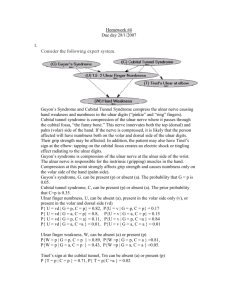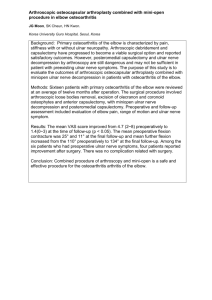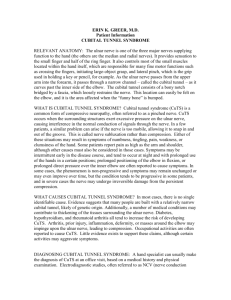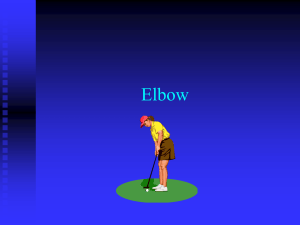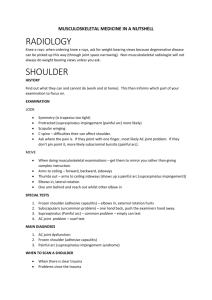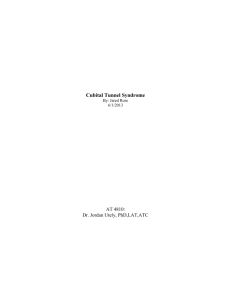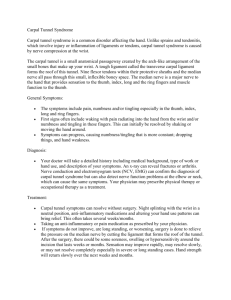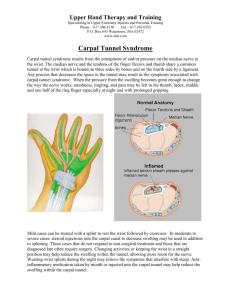View ePoster
advertisement
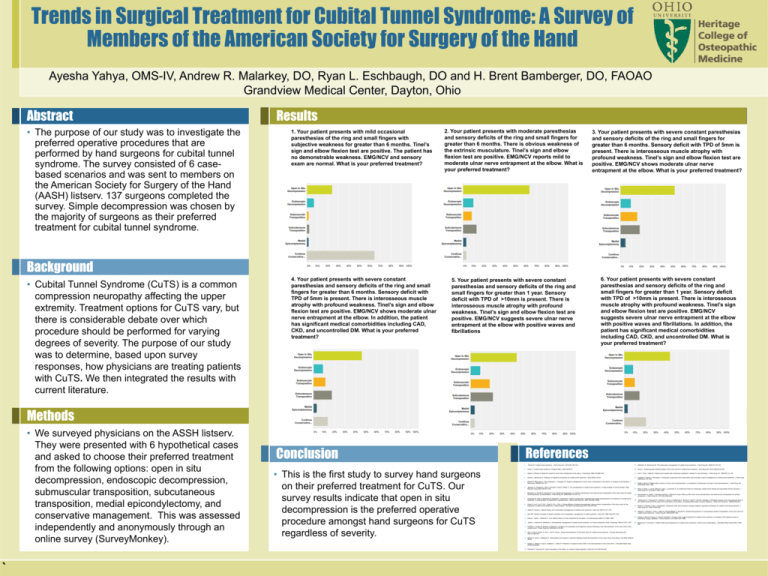
Trends in Surgical Treatment for Cubital Tunnel Syndrome: A Survey of Members of the American Society for Surgery of the Hand Ayesha Yahya, OMS-IV, Andrew R. Malarkey, DO, Ryan L. Eschbaugh, DO and H. Brent Bamberger, DO, FAOAO Grandview Medical Center, Dayton, Ohio Abstract • The purpose of our study was to investigate the preferred operative procedures that are performed by hand surgeons for cubital tunnel syndrome. The survey consisted of 6 casebased scenarios and was sent to members on the American Society for Surgery of the Hand (AASH) listserv. 137 surgeons completed the survey. Simple decompression was chosen by the majority of surgeons as their preferred treatment for cubital tunnel syndrome. Results 1. Your patient presents with mild occasional paresthesias of the ring and small fingers with subjective weakness for greater than 6 months. Tinel’s sign and elbow flexion test are positive. The patient has no demonstrable weakness. EMG/NCV and sensory exam are normal. What is your preferred treatment? 2. Your patient presents with moderate paresthesias and sensory deficits of the ring and small fingers for greater than 6 months. There is obvious weakness of the extrinsic musculature. Tinel’s sign and elbow flexion test are positive. EMG/NCV reports mild to moderate ulnar nerve entrapment at the elbow. What is your preferred treatment? 3. Your patient presents with severe constant paresthesias and sensory deficits of the ring and small fingers for greater than 6 months. Sensory deficit with TPD of 5mm is present. There is interosseous muscle atrophy with profound weakness. Tinel’s sign and elbow flexion test are positive. EMG/NCV shows moderate ulnar nerve entrapment at the elbow. What is your preferred treatment? 5. Your patient presents with severe constant paresthesias and sensory deficits of the ring and small fingers for greater than 1 year. Sensory deficit with TPD of >10mm is present. There is interosseous muscle atrophy with profound weakness. Tinel’s sign and elbow flexion test are positive. EMG/NCV suggests severe ulnar nerve entrapment at the elbow with positive waves and fibrillations 6. Your patient presents with severe constant paresthesias and sensory deficits of the ring and small fingers for greater than 1 year. Sensory deficit with TPD of >10mm is present. There is interosseous muscle atrophy with profound weakness. Tinel’s sign and elbow flexion test are positive. EMG/NCV suggests severe ulnar nerve entrapment at the elbow with positive waves and fibrillations. In addition, the patient has significant medical comorbidities including CAD, CKD, and uncontrolled DM. What is your preferred treatment? Background • Cubital Tunnel Syndrome (CuTS) is a common compression neuropathy affecting the upper extremity. Treatment options for CuTS vary, but there is considerable debate over which procedure should be performed for varying degrees of severity. The purpose of our study was to determine, based upon survey responses, how physicians are treating patients with CuTS. We then integrated the results with current literature. 4. Your patient presents with severe constant paresthesias and sensory deficits of the ring and small fingers for greater than 6 months. Sensory deficit with TPD of 5mm is present. There is interosseous muscle atrophy with profound weakness. Tinel’s sign and elbow flexion test are positive. EMG/NCV shows moderate ulnar nerve entrapment at the elbow. In addition, the patient has significant medical comorbidities including CAD, CKD, and uncontrolled DM. What is your preferred treatment? Methods • We surveyed physicians on the ASSH listserv. They were presented with 6 hypothetical cases and asked to choose their preferred treatment from the following options: open in situ decompression, endoscopic decompression, submuscular transposition, subcutaneous transposition, medial epicondylectomy, and conservative management. This was assessed independently and anonymously through an online survey (SurveyMonkey). References Conclusion • This is the first study to survey hand surgeons on their preferred treatment for CuTS. Our survey results indicate that open in situ decompression is the preferred operative procedure amongst hand surgeons for CuTS regardless of severity. References 1. Palmer B. Cubital tunnel syndrome. J Hand Surg Am. 2010;35A:153-163. 19. Hoffmann R, Siemionow M. The endoscopic management of cubital tunnel syndrome. J Hand Surg Br. 2006;31(1):23–29. 2. Cutts S. Cubital tunnel syndrome. Postgrad Med J 2007;83:28-31. 20. Flores L. Endoscopically assisted release of the ulnar nerve for cubital tunnel syndrome. Acta Neurochir 2010;152(4):619–625. 3. Dellon A. Review of treatment results for ulnar nerve entrapment at the elbow. J Hand Surg 1989;14A:688–700. 21. Tsai T, Chen I, Majd M. Cubital tunnel release with endoscopic assistance: results of a new technique. J Hand Surg Am. 1999;24(1):21–29. 4. Novak C, Mackinnon S. Selection of operative procedures for cubital tunnel syndrome. Hand 2009;4:50-54. 22. Yoshida A, Okutsu I, Hamanaka I. Endoscopic anatomical nerve observation and minimally invasive management of cubital tunnel syndrome. J Hand Surg 2009;34(1):115–120. 5. Bartels R, Menovsky T, Van Overbeeke J, Verhagen W. Surgical management of ulnar nerve compression at the elbow: an analysis of the literature. J Neurosurg 1998;89:722–727. 6. 7. 8. 9. Mowlavi A, Andrews K, Lille S, Verhulst S, Zook E, Milner S. The management of cubital tunnel syndrome: A meta-analysis of clinical studies. Plast Reconstr Surg 2000;106:327–334. Macadam S, Gandhi R, Bezuhly M, et al. Simple decompression vs. anterior subcutaneous and submuscular transposition of the ulnar nerve for cubital tunnel syndrome: a meta-analysis. J Hand Surg Am. 2008;33(8):1314.e1–12. Zlowodzki M, Chan S, Bhandari M, Kalliainen I, Schubert W. Anterior transposition compared with simple decompression for treatment of cubital tunnel syndrome. A meta-analysis of randomised, controlled trials. J Bone Joint Surg Am. 2007; 89:2591–2598. Chen H, Ou S, Liu G, Fei J, Zhao G, Wu L, Pan J. Clinical efficacy of simple decompression versus anterior transposition of the ulnar nerve for the treatment of cubital tunnel syndrome: a meta-analysis. Clin Neuro and Neurosurg 2014;126:150-155. 24. Mirza A, Mirza J, Lee B, Adhya S, Litwa J, Lorenzana D. An anatomical basis for endoscopic cubital tunnel release and associated clinical outcomes. J Hand Surg Am. 2014;39(7):1363-1369 25. Zimmerman R, Jupiter J, Gonzalez del Pino J. Minimum 6-year follow-up after ulnar nerve decompression and submuscular transposition for primary entrapment. J Hand Surg Am. 2013;38:2398-2404. 26. Gelberman R, Yamaguchi K, Hollstien S, Winn S, Heidenreich F, Bindra R, Hsieh P, Silva M. Changes in interstitial pressure and cross-sectional area of the cubital tunnel and of the ulnar nerve with flexion of the elbow. An experimental study in human cadavera. J Bone Joint Surg Am. 1998;80:492-501. 27. Dellon A, Chang E, Coert J, Campbell K. Intraneural ulnar nerve pressure changes related to operative techniques for cubital tunnel decompression. J Hand Surg Am. 1994;19:923-930. 10. Szabo R, Kwack C. Natural history and conservative management of cubital tunnel syndrome. Hand Clin 2007;23:311-318. 11. Idler RS. General principles of patient evaluation and nonoperative management of cubital syndrome. Hand Clin 1996;12(2):397–403. 12. Padua L, Aprile I, Caliandro P, et al. Natural history of ulnar entrapment at the elbow. Clin Neurophysiol 2002;113:1980–1984. 13. Dellon L, Hament W, Gittelshon A. Nonoperative management of cubital tunnel syndrome: an 8-year prospective study. Neurology 1993;43:1673–1677. 14. Goldfarb C, Sutter M, Martens E, Manske P. Incidence of re-operation and subjective outcome following in situ decompression of the ulnar nerve at the cubital tunnel. J Hand Surg Eur 2009;34(3):379-383. 15. Cho Y, Cho S, Sheen S, Choi J, Huh D, Song J. Simple decompression of the ulnar nerve for cubital tunnel syndrome. J Korean Neurosurg Soc 2007;42:382-387. 16. Nathan P, Istvan J, Meadows K. Intermediate and long-term outcomes following simple decompression of the ulnar nerve at the elbow. Chir Main 2005;24 : 29-34. 17. Krogue J, Aleem A, Osei D, Goldfarb C, Calfee R. Predictors of surgical revision after in situ decompression of the ulnar nerve. J Shoulder Elbow Surg 2015;24:634-639. 18. Chimenti P, Hammert W. Ulnar neuropathy at the elbow: an evidence based algorithm. Hand Clin 2013;29:434-442. ` 23. Watts A, Bain G. Patient-rated outcome of ulnar nerve decompression: a comparison of endoscopic and open in situ decompression. J Hand Surg Am. 2009;34(8):1492–1498. 28. Nabhan A, Ahlhelm F, Kelm J, Reith W, Schwerdtfeger K, Steudel W. Simple decompression or subcutaneous anterior transposition of the ulnar nerve for cubital tunnel syndrome. J Hand Surg Br. 2005;30:521-524. 29. Soltani A, Best M, Francis C, Allan B, Panthaki Z. Trends in the surgical treatment of cubital tunnel syndrome: an analysis of the national survey of ambulatory surgery database. J Hand Surg Am. 2013;38A:1551-1556. 30. Muermans S, De Smet L. Partial medial epicondylectomy for cubital tunnel syndrome: outcome and complications. J Shoulder Elbow Surg 2002;11:248252.
